optometry optometrists optometry optometrists optometry optometrists optometry optometrists optometry optometrists optometry optometrists optometry optometrists optometry optometrists
Refractive States Of The Eye
There are 4 main refractive states:
|
|
Astigmatism, myopia (nearsightedness), hyperopia (farsightedness),
and presbyopia are all refractive conditions of the eye.
You either have these, or you don't, and you just need a special
lens to correct these if you do. Wearing glasses or not wearing
glasses doesn't change your eyes one way or the other, but if
you do have a significant refraction (prescription), glasses will
allow your eyes to focus.
|
|
MYOPIC (nearsighted). This means that distance
vision will be blurred unless you wear your correction. Light
rays entering your eye focus not on, but in front of your retina.
|
A lens is required to move the focus point back onto the retina:
|
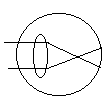 Myopic eye - focus in front of the retina
|
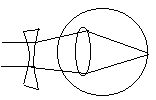 A concave lens corrects the focus
|
This
lens can be either spectacles or contact lenses. There are also
today several laser procedures available for the reduction of
myopia. For more information on spectacle lens options, see the Glasses
page.

|
ASTIGMATISM means that your eyes do not have
ONE clear focus point, but actually several in each eye, none
of which may be especially clear. This is not a disease, but a
refractive condition of the eye, and requires a special design
lens to correct. This may also require special design contact
lenses.
|
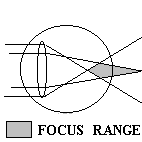 Astigmatic Eye |

|
HYPEROPIC (farsighted): This means that although you
may be able to see fairly well without glasses, your eyes must
focus harder than optimum in order to do this. The internal lens
in your eye is not quite strong enough to focus light on your
retina:
|
A lens is required to move
the focus forward to the plane of the retina: |
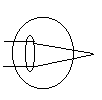 Hyperopia: light focusses behind the retina.
|
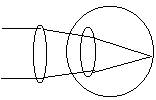 A concave lens corrects the hyperopia.
|
Most children tend to start out hyperopic, but tend to outgrow
this as they get older.

PRESBYOPIA Sometime in our early forties, everyone
ends up needing a different Rx for close work, compared to far
distance vision. This is called presbyopia and usually means BIFOCALS. The cause of this
annoying condition is the constant growth of the eye's internal
lens throughout our lifetimes: as the lens thickens, it loses
elasticity and thus it becomes harder to change focus from far
to near. You can choose between various types of lined bifocals,
or no-line lenses.
For more information about normal age changes in the
eye, see the Age Changes page
|






